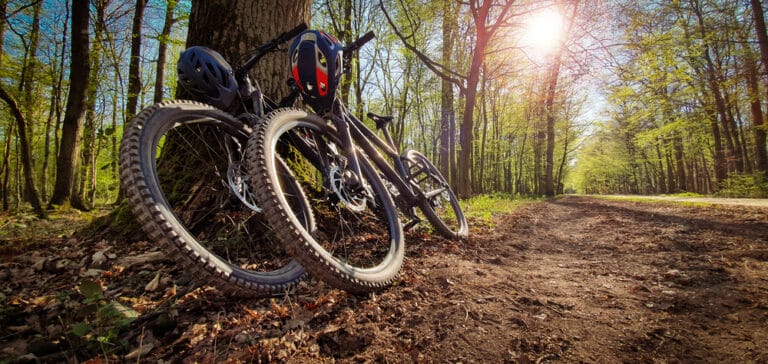How Many Calories Biking 10 Miles?

Riding a bike, whether stationary or outdoors, is an excellent form of exercise. You can burn a good amount of calories on a 10-mile bike ride, but several factors influence the final number. Some prefer to cycle 10 miles quickly and intensely, while others may prefer a slow and steady pace.
Biking for 10 miles can burn between 500 to 600 calories. The exact number depends on the speed and body weight. More calories are typically burnt with increased intensity of the ride. Outdoor versus stationary cycling also influences the number of calories burnt in 10 miles.
Ten miles equals approximately 16 kilometers. While this may seem far for an activity like walking or running, it is doable for cyclists, even beginners. This is because you can ride a bike for a longer time and build up endurance and muscle more quickly.
How Many Calories Biking 10 Miles?
Although there are several variables to consider, the average number of calories burnt on a 10 miles bike ride is 500 to 600. This is calculated based on a standard traveling speed, not considering intensity or body weight variations.
However, averages are a great point to work from. For instance, if you have just started biking and want to reach the 500-calorie mark, you know you need to bike for about 10 miles. If you prefer more specific goals, you’ll want to consider different factors, such as your body weight, the intensity of the workout, and even the terrain on which you bike.
Factors Influencing How Many Calories Biking 10 Miles
Some factors influencing calories burnt may be obvious, like body weight and the ride’s intensity. However, other factors such as age, resting metabolic rate, and sex may not seem as essential but still play a role.
Body Weight
A person’s body weight plays an important role in almost every activity, mainly when focusing on calories burnt. During 10 miles of bike riding, a 100-pound person and a 200-pound person will burn significantly different calories.
Although there is significant variation in body weight, there are some averages on which we can work. For instance, in the United States, the CDC (Centers for Disease Control and Prevention) state that the average weight for men is 199.8 pounds, and for women is 170.8 pounds.
As both of these figures are closer to 200 pounds than 100 pounds, you can estimate that during a 10-mile ride, someone around this weight will burn 340 calories. This number is based on a speed of only 10 miles per hour.
However, other sources claim that someone weighing about 170 pounds and going 10 miles per hour will burn up to 510 calories on their bike ride. This 10-mile journey takes around 1 hour to complete at this speed. Here you can already see the large variations in calorie calculators and the influence some factors have that may not be considered.
Speed And Intensity
In cycling, you can compare the speed approximately to the intensity of the workout. On average, people riding bikes in the city pedal at a rate of about 10 miles per hour. Of course, this figure would change for people cycling more seriously by going on a trip or cycling for the purpose of a workout.
Furthermore, the average speed range is quite large, from about 8 miles to 16 miles per hour. Of course, when you decrease the speed, it takes longer to complete the 10-mile ride. Going at a slower pace but riding for longer will only change the calories slightly.
Increased speed will burn more calories during a 10-mile bike ride. For example, most people can go 15 miles per hour, and you don’t have to be a professional racer to reach this speed. At this speed, an individual that weighs about 200 pounds will burn closer to 400 calories.
The same speed, but someone who is 150 pounds, will only burn 350 calories. If you increase the speed even more to around 20 miles per hour which really hikes up the intensity of the ride, you can expect 420 calories to be burnt (for someone weighing 200 pounds).
In general, the quicker the speed of the ride, the more calories will be burnt. Similarly, the heavier a person is, the more calories they will burn in a 10-mile ride. One of the more effective ways to burn calories on a 10-mile bike trip is to go about 13 miles per hour. This brings the total time down to about 45 minutes, and someone who is 198 pounds can burn up to 633 calories during this workout.
Type Of Biking
You can typically bike outdoors or on a stationary bike. You will burn slightly fewer calories in 10 miles on a stationary bike. For instance, one study showed that someone weighing 155 pounds burns about 260 calories at a moderate pace for 30 minutes.
However, outdoor biking burns a bit more calories but has other disadvantages, such as being more dangerous and prone to accidents or injuries. Many people use biking for transport, which has become part of their everyday life. Others do not have this option, so stationary biking is a great option for them.
Indoor biking can be done on your schedule and does not have to rely on the weather. However, outdoor biking can be very motivating, especially on further trips. It is more dynamic due to the changes in the physical surroundings and the weather. It has other benefits, such as being in nature and seeing different environments.
Other Variables
During outdoor biking, the terrain can affect the total number of calories burnt. Riding 10 miles over rougher and more challenging terrain can be more physically demanding. However, while a flat surface may be more manageable, you could go faster and for longer, ultimately pushing the calories up.
Your resting metabolic rate can also influence the number of calories burnt during a 10-mile bike ride. As with almost every other physical activity or workout, sex contributes to the total calories burnt. On average, and during most exercises, men burn more calories than women, and you would expect the same to apply to cycling.
Greater muscle mass will result in more calories burnt than less muscle mass, even if two people weigh the same. This is due to muscles burning more calories than fat. Men tend to have more muscle mass than women as they are generally larger, which is why they also manage to burn more calories.
Age is another variable to consider when calculating how many calories are burnt on a 10-mile bike ride. Due to losing muscle mass as we grow older, it is expected that older individuals will lose fewer calories. However, some research suggests that calorie burn only starts to decline from age 60 and before then reaches more of a plateau.
Fitness level is another prominent and essential aspect that affects the number of calories burnt in cycling. As bikers become more fit, the calories burnt during exercise will start to decrease. When you notice this, it may be an excellent cue to increase the intensity of your bike ride, for instance, the speed. Alternatively, you could bike for more than 10 miles to improve your fitness levels.

Is Biking 10 Miles A Good Way To Burn Calories?
Riding a bike is one of the optimal ways to get some exercise, burn calories, and receive other health benefits, all in a low-impact manner. It is not a weight-bearing activity like running or walking and places less stress on the knee and ankle joints.
Compared to walking 10 miles, cycling for 10 miles appears to be a more time-effective and efficient way to burn those calories. Biking at a speed of 10 miles per hour and up will burn fat and help build muscle growth.
Not only are the various leg muscles involved, but you must engage your core and shoulder muscles to stay in the correct position for a long time. Biking 10 miles is a great way to burn calories, but you may notice that you can go even further than that, especially at a lower intensity (speed).
As beginners increase their speed and strength, biking 10 miles becomes shorter in time and, therefore, even more effective at burning calories. However, cycling has several other health and fitness benefits besides calorie burning.
Cycling regularly can lower your risk of heart disease. Using a bike to travel to work or other places is a great way to stay active in an otherwise busy lifestyle. If biking outside is not available to you, then using a stationary bike at the gym can be equally effective in burning calories.
Conclusion
Biking for 10 miles can burn between 500 and 600 calories. Calories burnt can increase or decrease depending on the ride’s intensity, thus speed, and body weight. Other variables that play a role include age, sex, fitness level, type of cycling, and terrain during outdoor riding.
References
- https://healthyliving.azcentral.com/calories-burned-cycling-10-miles-16305.html
- https://www.livestrong.com/article/315685-how-many-calories-are-burned-after-biking-10-miles/
- https://www.cdc.gov/nchs/fastats/body-measurements.htm
- https://www.medicalnewstoday.com/articles/calories-burned-biking#stationary-vs-outdoor
- https://www.healthline.com/health/how-many-calories-do-you-burn-biking#indoor-biking
- https://www.everydayhealth.com/fitness/factors-that-can-affect-how-many-calories-you-burn/







